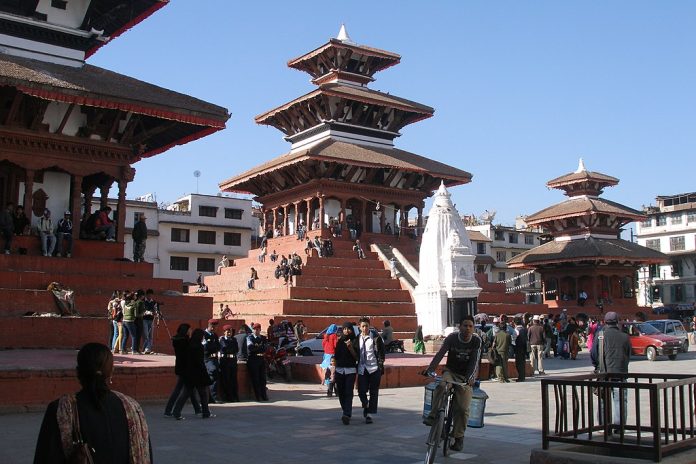Measuring the Next Uprising Through the Economic Crime and Geopolitics Index
A woman was burnt alive. She was the wife of a former prime minister of Nepal. Her death, brutal and symbolic, speaks to the fragility of a nation where fire now consumes not only people but also the old guard of politics. Days later, another woman took office as the first female prime minister of Nepal.
I have walked this geography for years—from Everest base camp to the narrow streets of Kathmandu. I have spoken to students, shopkeepers, scholars, and diplomats and even to Nepal’s only billionaire, Binod Chaudhary, who whisper more than they speak. In May 2024, during my book talk in Kathmandu, where I shared Sri Lanka’s story, I felt the silence breaking. Youth were restless. Their anger was familiar: the same corruption, wasteful projects, and hopeless migration driven by a lack of opportunity and jobs that had broken my own country, Sri Lanka. Governments promised development but delivered white elephants. Families survived by sending their children abroad. At home, constitutions were mocked, and no prime minister had finished a full term in decades.
Nepal mirrors the region’s failures. Bangladesh, Sri Lanka, and now Kathmandu—all caught in a cycle of corruption and betrayal. The small states live under giants. Nepal shares a largely open border of more than 1,750km (1,080 miles) with five Indian states—Uttarakhand, Uttar Pradesh, Sikkim, Bihar, and West Bengal. Geography itself presses on its politics. “We must be careful,” a Nepali think tank director whispered to me. “We are too small. We have no power.” It is a truth many in South Asia carry: geography demands silence, even when injustice screams.
September began with two daggers thrown to Rome, modern-day Washington, D.C.: a triumvirate clasping hands—China, India, and Russia—in Tianjin. In the backdrop, President Xi launched the Global Governance Initiative (GGI), signaling with clarity that “China intends to lead the development of a new international order,” argues Henrietta Levin of CSIS. Three days later, another triumvirate—China, Russia, and North Korea’s autocrat—assembled in Tiananmen Square, displaying weaponry with more than 10,000 troops. Within days of these non-Western designs on display, a strategically located nation, Nepal, burns with protest. The flames turn to mob violence, triggering instability in the immediate periphery of India and China. This is no coincidence. South Asia’s upheavals, often dismissed as local convulsions, are in fact inseparable from the tectonic shifts of global power.
And yet the uprising came. Explanations followed in torrents. Some called it a CIA operation, including a former Indian Major General. Others said it was triggered due to the U.S. Millennium Challenge Corporation (MCC), by uranium deposits near Nepal’s Upper Mustang, by Indian intelligence backing monarchists to oust the Marxist regime, by the shifting sands of India–China rivalry. Each story offered fragments of truth, but none captured the whole. What mattered was not the rumor, but the fact: people rose, and they had not foreseen it.
The pattern, however, was visible. In Colombo, one year before the flames, I sensed anarchy pressing in. In Dhaka in 2023, I asked military officials if Colombo’s uprising could happen there. Impossible, they said. They were wrong. In Cambodia in 2024, at the Royal Academy (IRIC), the trajectory toward Nepal was mapped out. Hours after the uprising, a Chinese scholar who had challenged the analysis called to concede it had been correct.
This was not prophecy but pattern. Across South Asia, two forces corrode states from within—economic crime and geopolitics. Together, they strip citizens of dignity, fuel despair, and prepare the ground for revolt. Corruption robs daily life of meaning. Geopolitical pressures suffocate sovereignty. When both converge, the people turn. They burn the symbols of power. They punish the leaders who inflicted pain. And then, without direction, they hand power to new faces at elections.
Colombo. Dhaka. Kathmandu. The cycle repeats. In Dhaka, the fury turned brutal— nearly 1400 killed in a single wave, buildings destroyed, mobs unchained. Youth who had marched for hope unleashed violence instead when attacked by the authorities. In Nepal, the toll reached 51 deaths. The same frustration now grows in Indonesia. The question is not if another uprising will come, but where.
To assess this fragility, I designed the Economic Crime and Geopolitics Index (ECGI), currently in testing provides a tool that forecasts political fragility. It is a warning system, forecasting political instability rather than offering prophecy. A way to measure the dry wood and the spark before the fire takes hold.
The ECGI rests on four variables: Corruption Perception Index (CPI Score): how citizens perceive public corruption. Economic Crime Severity: the scale of fraud, illicit flows, and misconduct hollowing economies. Public Response Intensity: the willingness of people to protest, march, revolt. Geopolitical Influence: the pressure of foreign powers and investments on domestic fragility.

Each variable is normalized and weighted, producing a score based on field research data from South Asia and Southeast Asia that shows which countries edge closest to fracture. Scores above 70 indicate high-risk nations (See Graph, under development). Unlike traditional corruption indices or economic metrics, the ECGI ties systemic corruption and economic crime, popular anger, and geopolitics together. It captures the interaction of the street and the state, of local betrayal and external pressure.
Out of nine nations classified as high risk, three have already undergone the full cycle from uprising to new regime. The remaining six face significant instability—ranging from civil war in Myanmar, to continuous protests in Indonesia and India, to the tightening autocratic grip in Cambodia, Pakistan’s recurring cycles of political collapse, and Afghanistan’s enduring governance vacuum under the Taliban.
Already, the rationale and methodology circulate within the Millennium Project’s network of more than seventy countries, where the ECGI will be refined and expanded as a tool. Policymakers, regional bodies, and international actors can use it to see where instability grows—and act before lives are lost.
But the ECGI is only a mirror. It shows the cracks. It cannot heal them. What governments choose to do is another matter.
The lesson is stark. Where corruption festers and geopolitics strangles sovereignty, revolt becomes inevitable. It may be peaceful. It may be violent. But it comes. Leaderless movements are dangerous because they devour without building. They sweep away the old order but offer little beyond new faces and fragile promises. Amish Mulmi rightly observes “The struggle will be to rebuild the system itself ..a much longer struggle. It’s always easier to burn a building down than to build an institution. To do so now, in the face of a constitutional absence, will be doubly difficult”.
The woman burnt alive was not only a victim of personal cruelty but also of political decay. Her death belongs to the same story as the uprisings that sweep across the region. It is the story of nations consumed from within, of people stripped of dignity, of cycles that repeat until leaders understand that corruption and geopolitics are not abstractions but fire itself.
The fire will come again. The only question is—where next?

Asanga Abeyagoonasekera
Asanga Abeyagoonasekera is the Foreign Affairs Editor at Global Strat View. Hewas a technical advisor to Sri Lanka’s Governance Diagnostic Report by IMF, a Senior Fellow at the Millennium Project in Washington DC, member of the International Federation of Journalists (IFJ) and the National Press Club in Washington DC. and the author of ‘Teardrop Diplomacy: China’s Sri Lanka Foray’published by Bloomsbury (2023).









